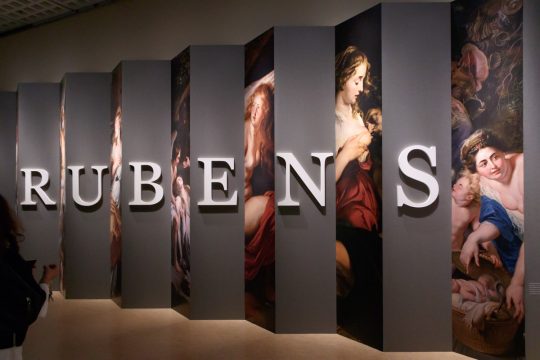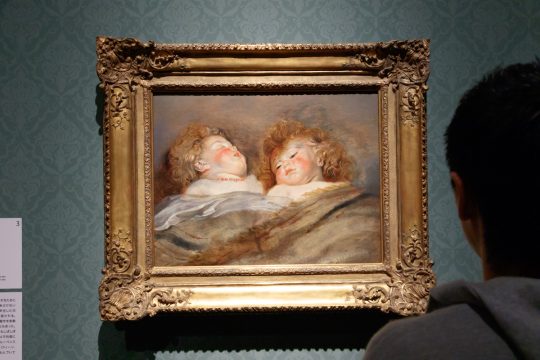The National Museum of Western Art

Rubens and the Birth of the Baroque will be held at the National Museum of Western Art, Tokyo from October 16 (Tue) 2018 to January 20 (Sun) of 2019. Since the media exhibition was held on 15th October, I will tell you the situation.
Peter Paul Rubens (1577-1640), a painter representing 17th century baroque art.
Dramatic composition with a lot of movement, brilliant color, abundant and fascinating nudity expression. Rubens, who was sent with the highest compliment of "King of Painters as King's Painter" by those who were fascinated by the style, was able to bring its name to other countries.
Although Rubens set up the workshop in Antwerpenand,Belgium,and made the base of its activities as the base of its activities, but it is not well known in Japan that he spent in Italy for 8 years immediately after being independent as a painter. Rubens absorbed various expressions in Venice and Mantova, especially in Rome, and established a style of painting, and developed it after returning home.
This exhibition focuses on the relationship between Rubens and Italy and attempts to unravel the secret of its creation. We exhibited a total of 71 works by Rubens and ancient art, Italian artists, and we will explore how Rubens got inspiration and gave it from Italian works.
Chapter 1 The World of Rubens


This exhibition consists of seven parts. Works are displayed by theme, not time series, and Rubens and Italy, we will explore the source of that idea from bidirectional exchanges. In this chapter which will be the introduction, his representative portrait works are exhibited, you can see the features of the technique greedily absorbing the Italian style and the love affection to the family.

This is a work "Portrait of Clara Serena Rubens" . It depicts the eldest daughter Clara Serena born with the first wife Isabella Brant. Although the background and the collar part are roughly caught, the expression is drawn very carefully and the composition taking the face of the model directly in front is also impressive.
Clara was about 5 years old at this time, but then died at the young age of 12 years old. Rubens loved Clara and seems to have portrayed her portraits many times even after she died.
Chapter 2 Past traditions



In the second chapter, entitled "Past tradition", we introduce Rubens' works, as well as replications of Venetians by ancient sculptures and Rubens.

"Death of Seneca" is a work depicting the end of Seneca, a philosopher who was ordered to commit suicide under suspicion of a conspiracy to the emperor Nero, as the subject said. Seneca in the picture is based on the famous ancient sculpture in the Louvre museum, and Rubens which saw this sculpture in Rome has left six drawings. It can be said to be a good example of the results of classical learning by Rubens.
Chapter 3 Saints as Heroes – Religious Painting and Baroque



During his stay in Italy, Rubens painted religious paintings in Mantua, Genoa and Rome. Rubens'. His religious painting, which showed an ideal body image like ancient sculpture, fascinated the young generation and showed the greatest innovation in Rome after Caravaggio.
In chapter 3, Rubens' religious paintings are displayed together with the works that influenced him and the works he influenced .

Rubens' masterpiece "Martyrdom of St. Andrew" first came to Japan. This work was donated to the chapel of the Royal Hospital of Santandres de los Flamencos in Madrid and it seems to be very valuable thing to appreciate rarely.
"Martyrdom of Saint Andere" depicts the martyrdom of Saint Andrew, described in the "Golden Legend" of Jacobos de Worragine. Saint Andrew, cruised by the Roman governor, taught to the crowd of 20 thousands who surround him. The crowd threatened to angrily thrust the governor down from the cross, but Andrew declined to descend from the cross as he lived, and ascended by casting pray as it was.
Saint Andrew looking up to the heavens above which one light shines, angels flying to Andrew from the dark sky, people crying something and appealing. It is extremely dramatic, and the depiction of realism with dynamic feeling approaches to my heart.
Chapter 4 The Power of Myths 1 – Hercules and Male Nude


Rubens who was fascinated by famous sculpture "Hercules of Farnese" and learned its shaping deeply. His imagination was demonstrated most vividly, especially when drawing a mythical world. In this chapter, a lot of male nude by Rubens and Italian painters after Rubens are exhibited.
Chapter 5 The Power of Myths 2 Venus and Female Nude


On the other hand, this chapter features a nude that depicts the ideal woman beauty symbolized by Venus. When drawing Venus it was also Rubens who took the form of ancient sculpture, but in the later years it began to draw a plump woman that symbolizes more realistic and fertile.
Chapter 6 Pencil Frenzy


Brilliant colors and quick brush usage that gives it to the screen. The 17th century artist theorist Bellori explained Rubens' paintings with the word "painter's enthusiasm" . In Chapter 6, we take up paintings such as battle scenes in which the character of such Rubens art was expressed in the most obvious way, and focus on its characteristics.

"The Fall of Phaeton" painted around 1605 during my stay in Italy. The sun of Apollo, the sun god, a painting capturing the moment when Paeton’s tanks receive lightning from the supreme god Jupiter and Paeton is about to fall. The cloaking cloak, the mane of the standing horse, the lightning running in the sky enhance the violent dynamism of the whole screen.
Chapter 7 Allegorical and Allegorical Tales



Rubens was a succeeded highly educated diplomat . Rubens took advantage of its cultural knowledge and knowledge and often painted allegorical figures that used a combination of symbols. In the final chapter, Rubens' mythological theme with alleged gimmicks is displayed along with ancient sculptures.

"Mars and Rare Sylwia" depicting scenes where Military God Mars looks at the shrine maiden Rae Sirwia who protects the fire of the West Temple. It is famous that twins born between Rare Sylwia and Mars grew and became Romulus and Romulus with Rome.
Rubens usually makes a bold change to the traditional interpretation, as the stage of this work is a temple, whereas Rare Sylwia who went to draw water usually is fucked by Mars in the forest. At the same time, however, Rubens also shows that it is very precisely taken into account the ancient literature on this myth, such as Cupid and Mars' weapons and feet clouds that cloak the cloak's hem.

"I think that Rubens' work is reflected very well in his work, generous, loving and great, I feel that his figure is also bleeding out of paintings A biographer described him as "Maestoso Umano (dignified person) and at the same time it is full of humanity", but in fact Rubens expressed a very deep affection for family members and friends He was a pouring person. "
That is what I talked about, as an art historian and Mr. Anna bio Bianco, supervisor of this exhibition.
"In addition, when Rubens was asked" What are you from? ", He said that" I am a world citizen. "Well these words have come to be used now, but in the 17th century Rubens thought so that at the point of time.Though it was the owner of the idea he advanced and I understood the wonderfulness of fraternity, it can be understood from this remark.In this exhibition, I hope to focus on human nature and enjoy it. "
Called "King of painters", I will unravel the painting and humanity of the master who built one era in relation to Italy.
"Rubens exhibition – the birth of baroque" is held until January 20, 2019 (Sunday).
Why do not you visit this opportunity?

Summary
| Exhibition name | Rubens and the Birth of the Baroque |
| Dates | October 16 (Tuesday) 2018 to January 20 (Sunday) 2019 9: 30 ~ 17: 30 Every Friday and Saturday: 9: 30-20: 00 (9: 30 ~ 17: 30 on 17th November) ※ Admission ends 30 minutes before closing time |
| closing day | Mondays (Except 24 December and 14 January) and 28 December-1 January, 15 January |
| Venue | The National Museum of Western Art The National Museum of Western Art, Tokyo 7-7 Ueno-Koen, Taito-ku, Tokyo, 110-0007 JAPAN |
| Admission fee | General: Adults 1,600 yen,college students,1,200 yen, high school students 800 yen Group: Adults 1,400 yen, college students 1,000 yen, high school students 600 yen ※Junior high school and younger children admitted free of charge. ※Visitors with physical disabilities admitted free with one accompanying adult (ID required). ※Group purchase: more than 20 people. |
| Official site | http://www.tbs.co.jp/rubens2018/english/ |
Article Provided by: Kokosil Ueno
